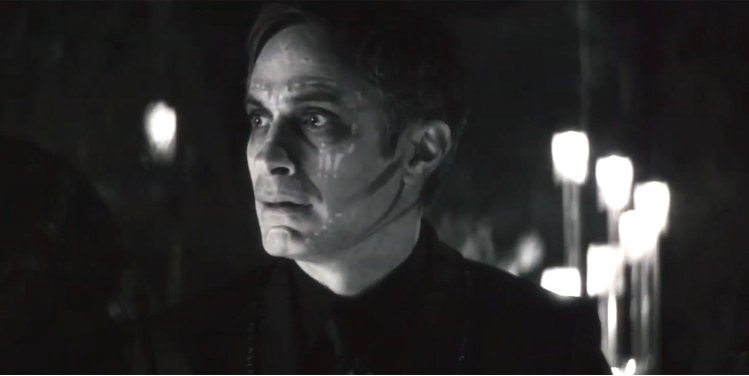Picture this: you’re watching a black-and-white film released in 2022 exclusively for streaming, when suddenly at the halfway point a small image flickers in the top-right of the screen: a white circle, sometimes known as a ‘cigarette burn’.
This image is commonly used to signal projectionists to change the reels on an old film – at least it was, back in the day when a feature presentation couldn’t physically fit onto one reel and instead came as a collection of two or more cans.
But it’s been decades since this was in practice – so why is it there?
What is Werewolf by Night?
Werewolf by Night is a one-off ‘special TV presentation’ directed by Michael Giacchino (whom you may be familiar with as the composer for Dr Strange and The Incredibles), which is now available to stream on Disney+. The special follows a secret group of monster hunters as they compete for a powerful relic, the Bloodstone, while going up against a dangerous labyrinth-bound monster.
A couple of things are noteworthy about Werewolf: one being that ‘TV specials’ are a thing of the past, so it’s an odd classification given that it’s only available to stream and not being broadcast live. But it’s not really a movie or a short film, either. Coming in at 55 minutes, and committing completely to a 1930s tone and aesthetic, it really is a difficult beast to describe.
Let’s talk about why it looks the way it does: old, campy, full of niche cinematic references. What exactly is going on there?
Horror origins, or: horrorgins
In the 1930s, Universal Studios was the reigning king of horror films. Frankenstein, Dracula, The Mummy, and The Invisible Man were all defining horror pictures of the time – and what made Universal a household name for decades to come.
In those days colour film had already been invented, but it was prohibitively expensive to use, and audiences seemed to prefer the good ol’ monochromatic style anyway. Thus, costumes and sets had to be opera-levels of over the top, otherwise they would blend into the background, totally undistinguishable.
Special effects were all done practically, using in-camera tricks, matte paintings and overlays, and early forms of rotoscoping. This gave flicks like Bride of Frankenstein such a unique look that its images still remain in pop culture today. Take a look at the instantly recognisable characters below:
The performances themselves, as we can see above, were also quite over the top, as most of the actors had their origins in stage plays. Bella Lugosi and Boris Karloff, as Dracula and Frankenstein’s monster, respectively, became cultural icons as synonymous with horror characters as Universal was with horror films in general. The ominous walk, the stare down the camera barrel, the deep booming voice of the monster or the sinister whisper of the vampire: we understand these performances as corny now, but they essentially laid the blueprint for all horrors to come.
Paying respects
Werewolf by Night, in a delicious homage to such films, doesn’t hold back. Gael García Bernal leans into the cool 1930s leading-man vibe, and doesn’t shy away from the ridiculous idea that a man named Jack Russell turns into a werewolf at night. The makeup and costumes are both faithful to their comic book origins and to the aesthetic of films like White Zombie (not a Universal, but still a great example of that era).
Harriet Sansom Harris must be given special mention for her wonderfully camp performance as Verussa: the host of the night hunt and mistress of the Bloodstone mansion. She’s like if Moira Rose and Dr Frank ‘N’ Furter had a baby, who dressed exclusively in high-collared capes. Wonderfully kooky, and so well suited to this particular assignment.
Of course, rather than shooting on precarious and expensive old film, the post-production people have edited and colour graded Werewolf to achieve its monochromatic film look, complete with ‘grain’ to make it seem aged (and the cigarette burn as mentioned above). It has no practical purpose in 2022, it’s simply there to complete what is a full ‘commitment to the bit’. And it looks hella cool.
The title fonts are also purposefully chosen to imitate those popular in the 1930s, most notably when we are treated to a title card at the very beginning of the film – a trend that is long dead. But then again, what is the central theme of this movie if not reviving the dead?
Horror from the 1930s that may have inspired Werewolf by Night:
Bride of Frankenstein
White Zombie
Dracula
And of course, Werewolf of London – they practically recreated this exact werewolf look on Gael Garcia Bernal.
Werewolf by Night is available to stream on Disney+





